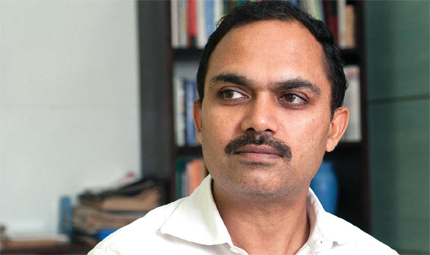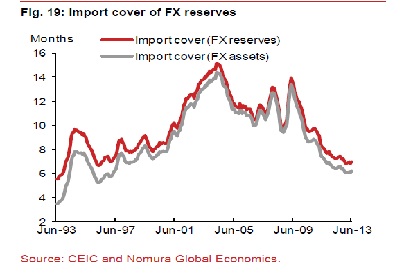Sometime in late October I went to meet my investment advisor. During the course of our discussion he suggested that my portfolio was skewed towards HDFC Mutual Fund and it would be a good idea to move some money out of it, into other funds.
“Don’t put all your eggs in one basket” is an old investment adage. While, I try to follow it, I also like to believe that if the basket is good enough, it makes sense to put more eggs in that basket than other baskets.
HDFC Mutual Fund has been one of the few consistent performers in the Indian mutual fund space. And a major reason for the same has been Prashant Jain, the chief investment officer of the fund, who has been with it for nearly two decades.
Jain has been a star performer and due to his reputation the fund has seen a huge inflow of money into its various schemes. Some of these schemes HDFC Prudence, HDFC Equity and HDFC Top 200 became very big in that process.
These schemes haven’t done very well over the last three years. Their performance has been significantly worse in comparison to other schemes in their respective categories(Value Research has downgraded them to three star funds from being five star funds earlier). And this has surprised many people. “How can Prashant Jain not perform?” is a question close observers of the mutual fund industry in India have been asking.
One explanation that people seem to have come up with is the fact that the size of the schemes have become big, making it difficult for Jain to generate significant return. This is a theory that is globally accepted, where the size of a scheme is believed to be inversely proportional to the return it generates.
As Jason Zweig points out in the commentary to Benjamin Graham’s all time investment classic, The Intelligent Investor, “As a (mutual) fund grows, it fees become more lucrative – making its managers reluctant to rock the boat. The very risk that managers took to generate their initial high returns could now drive the investors away — and jeopardise all that fee income. So the biggest funds resemble a herd of identical and overfed sheep, all moving in sluggish lockstep, all saying “Baaaa” at the same time.”
While this may be a reason for the underperformance of the schemes managed by Jain, it is not easy to prove this conclusively. Jain feels there is no correlation between size and performance of a scheme, or so he told the Forbes India magazine in a recent interview. He pointed out that there are no large mutual fund schemes in India, and the largest scheme is less than 0.2% of the market capitalisation, which I guess is a fair point to make.
So how does one explain the fact that Prashant Jain is not doing as well as he used to in the past. John Allen Paulos possibly has an explanation for it in his book A Mathematician Plays the Stock Market. As he writes “A different argument points out to the near certainty of some stocks, funds, or analysts doing well over an extended period of time.”
Paulos offers an interesting thought experiment to make his point. As he writes “Of 1000 stocks (or funds or analysts), for example, roughly 500 might be expected to outperform the market next year simply by chance, say by the flipping of a coin. Of these 500, roughly 250 might be expected to do well for a second year. And of these 250, roughly 125 might be expected to continue the pattern, doing well three years in a row simply by chance. Iterating in this way, we might reasonably expect there to be a stock (or fund or analyst) among the thousand that does well for ten consecutive years by chance alone.”
But one day this winning streak comes to an end. And the same seems to have happened to Prashant Jain. In fact, William Miller who ran the Legg Mason Value Trust fund in the United States, beat the broader market every year from 1991 to 2005. In 2006, his luck finally ran out. Miller once explained his winning streak by saying “As for the so-called streak…We’ve been lucky. Well, maybe it’s not 100% luck—maybe 95% luck.”
If Miller was lucky so was Jain. Any significant deviation from the norm does not last forever. As Nassim Nicholas Taleb writes in Fooled by Randomness “In real life, the larger the deviation from the norm, the larger the probability of it coming from luck rather than skills…The “reversion” for the large outliers is what has been observed in history and explained as regression to the mean. Note the larger the deviation, the more important its effect.”
This is not to suggest that Jain’s performance has only been because of luck. Not at all. But it was luck that pushed him up to the top of the charts. Luck was the “icing” on the cake.
Michael Mauboussin discusses a very interesting concept called the paradox of skill in his book The Success Equation – Untangling Skill and Luck in Business, Sports, and Investing. “As skill improves, performance becomes more consistent, and therefore luck becomes more important,” is how Mauboussin defines the paradox of skill.
The Olympic marathon is a very good example of the same. Men run the race today about 26 minutes faster than they did 80 years back. Also, in 1932, the difference between the man who won the race and the man who came in twentieth was 40 minutes. Now its less than 10 minutes.
Now the question is how does this apply to investing? “As the market is filled with participants who are smart and have access to information and computing power, the variance of skill will decline. That means that stock price changes will be random and those investors who beat the market can chalk up their success to luck. And the evidence shows that the variance in mutual fund returns has shrunk over the past 60 years, just as the paradox of skill would suggest,” says Mauboussin. “I want to be clear that I believe that differential skill in investing remains, and that I don’t believe that all results are from randomness. But there’s little doubt that markets are highly competitive and that the basic sketch of the paradox of skill applies,” he adds.
And that is what best explains the curious case of Prashant Jain and the recent non performance of the mutual fund schemes that he manages.
The column originally appeared in the Wealth Insight magazine edition of December, 2013
(Vivek Kaul is the author of Easy Money. He tweets @kaul_vivek)





